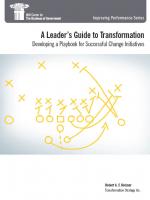
A Leader’s Guide to Transformation

The publication of this report is particularly timely. The summer of 2011 was dominated by negotiations between Congress and the president concerning the deficit of the United States and the need to dramatically reduce federal spending in the decade ahead. There is little doubt that agencies across government will need to cut costs while maintaining, if not improving, the performance of their operations. The challenge thus facing government executives will be whether to use this unprecedented opportunity to transform their organizations while also making the necessary reductions in spending.
To assist government leaders in better understanding the characteristics of successful transformations, the IBM Center asked Robert Reisner, an expert in government transformation, to interview a select group of federal executives who have recently undertaken major transformation initiatives in their organizations. Based on these interviews, Mr. Reisner framed a series of interrelated steps which government executives should consider when they undertake any transformation initiative:
- Develop a compelling transformation game plan
- Align the transformation game plan with your mission
- Center your game plan with a reliable innovation process
- Transform strategically
- Design implementation to sustain transformation
Transformational change is not the steady, incremental improvement most government officials have spearheaded in the past. Success in transformation depends on getting the right changes done right. A key lesson from those interviewed is that transformation is indeed hard work, requiring intensive engagement with all stakeholders, including employees. All the leaders interviewed emphasized the importance of engaging employees and other stakeholders to shape the transformation. The goal of the transformation initiatives described in this report is to substantially change the way the organization operates, while building upon the history and culture of the organization. Transformation is clearly not for the faint-hearted, and in the modern networked age, it is likely to be far more consuming than any strategic challenge that has come before.
It is time for new ideas, re-thinking of old models, and the enthusiasm of new leadership to tackle old problems with fresh ideas and energy. We trust that this report will be a useful and informative guide for government executives at the federal, state, and local level as they work toward transforming their organizations for the future.



